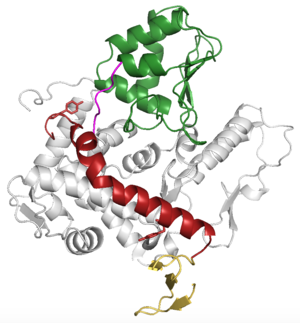
WWP2 Scheme without C2 Domain

WWP2 Scheme WW2-2,3-linker-HECT
Full-length WWP2 consists of an amino-terminal C2 domain, four WW domains (labeled WW1-WW4), and a carboxy-terminal HECT domain. WW domains are one of the smallest studied protein modules, consisting of less than 40 amino acids, fold into three-stranded beta-sheets. They are characterized by two highly conserved positioned 20-22 amino acids apart and a high affinity for proline-rich motifs. Linkers of varying length and secondary structure connect the C2 domain to WW1, WW1 to WW2, WW2 to WW3, WW3 to WW4, and WW4 to the HECT domain. A chimeric of WWP2 consisting of the , the WW2-WW3 linker (), and the HECT domain is shown on the right.
The HECT domain is divided into two lobes (labeled N and C). The N-lobe (silver) serves as a binding site for the E2-ubiquitin complex and includes an exosite for non-covalent ubiquitin binding relevant to autoinhibition while the C-lobe (green) contains an active site with a catalytic Cys residue to which the substrate ubiquitin molecule can covalently attach. A (magenta) connects the N and C lobes of the HECT domain and allows for flexible movement of the lobes as ubiquitin is transferred from the E2-ubiquitin complex docked on the N-lobe to the ubiquitin binding site in the C-lobe. A transthiolation reaction in this active site results in a thioester bond between the ubiquitin and a Cys residue. The HECT domain is in an inverse T shape when inactive (autoinhibited) and takes on an L shape when active. WW2 interaction with HECT is mediated by the six C terminal residues.
The alpha-helical 2,3-linker is subject to tyrosine phosphorylation at either end of the linker at residues Tyr369 and Tyr392. Chen et. al. have shown that the phosphorylation of Tyr369 allows for allosteric activation by ubiquitination at the exosite in the N-lobe, while phosphorylation of Tyr392 residue leads to a destabilization of the T conformation of the HECT domain.
Function
Studies suggest that the non-catalytic C2 domain and WW domains play a regulatory role in the catalytic activity of the HECT domain. Genetic deletions of WW domains and linkers have shown increased autoubiquitination activity. The WW domains and linkers play a role in altering protein conformation, with the 2,3-linker playing the greatest role.
This linker plays an autoinhibitory role. The ground state conformation of the protein has the 2,3-linker close to the N-lobe, while WW1 and WW2 domains block the N lobe’s ubiquitin-binding site. Upon phosphorylation the 2,3-linker changes conformation, moving further from the N lobe, allowing the protein to bind ubiquitin in the E2 and N lobe binding sites. This binding will further open the protein up to bind possible substrates, like PTEN.
Interactions between the hinge and the 2,3-linker appear to restrict flexibility of the C-lobe which is necessary for ubiquitin transferase activity. This interaction further locks the protein into the T position. A current model of WWP2 activation by Chen et. al. proposes the following: (1) autoinhibited WWP2 gets phosphorylated at the 2,3-linker, (2) loosening of the 2,3-linker interactions with the hinge and ubiquitin binding exosite allow ubiquitin to bind in the C-lobe, (3) the target substrate protein binds with specifity towards the WW domains, (4) the substrate protein gets ubiquitinated, and (5) the 2,3-linker gets dephosphorylated, allowing WWP2 to return to the autoinhibited ground state conformation.
Relevance
Mutations in the NEDD4 family of proteins have been associated with several cancers and immune disorders. Many of these mutations occur in the 2,3-linker/HECT autoinhibited domains and the modified activity of the E3 Ligases as a result of these mutations can lead to an increase in the growth of tumor cells. WWP2 may play a role in the regulation of oncogenic signaling pathways through interactions with its substrate PTEN, a tumor suppressor in the PI3K pathway. The downregulation of voltage-gated sodium channels by WWP2 and other members of the NEDD4 family is an active area of research.
References
1. Chen, Z., Jiang, H., Xu, W., Li, X., Dempsey, D. R., Zhang, X., . . . Cole, P. A. (2017). A Tunable Brake for HECT Ubiquitin Ligases. Molecular Cell, 66(3), 345-357. doi:10.1016/j.molcel.2017.03.020 PMID:28475870
2. Ingham, R.J., Gish, G., & Pawson, T.(2004) The Nedd4 family of E3 ubiquitin ligases: Functional diversity within a common modular architecture. Oncogene, 23(11), 1972-1984. doi:10.1038/sj.onc.1207436

